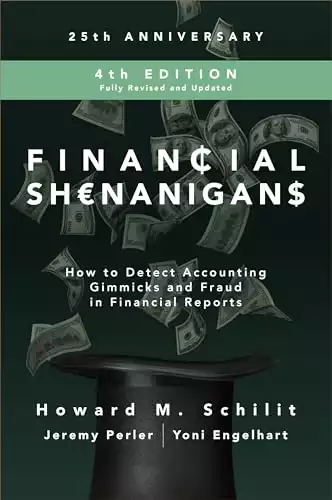Overview : Financial Shenanigans: How to Detect Accounting Gimmicks and Fraud in Financial Reports
- Book Title: Financial Shenanigans
- Author: Howard Schilit, with Jeremy Perler
- Publication Date: April 2018 (4th edition)
- Rating: 4.5
- price: $31.68
- Pages: 352
About the Author
"Financial Shenanigans," authored by Howard Schilit, delves into the manipulative accounting tricks and deceptive financial reporting practices that companies use to mislead investors. This insightful book helps readers spot red flags in financial statements and understand the subtle ways companies may manipulate numbers.
Financial Shenanigans Book Introduction
In an era of complex financial markets and increasingly sophisticated accounting practices, Howard M. Schilit and Jeremy Perler's "Financial Shenanigans: How to Detect Accounting Gimmicks & Fraud in Financial Reports" stands as a beacon for investors navigating treacherous waters. Now in its fourth edition, this comprehensive guide illuminates the dark corners of financial reporting, where numbers can be twisted to create illusions of corporate health.
Financial Shenanigans Book Summary
"Financial Shenanigans" serves as an indispensable manual for anyone looking to pierce the veil of deceptive accounting practices. The authors, drawing from their extensive experience in forensic accounting, meticulously dissect the various tactics companies employ to inflate their financial performance and mislead stakeholders.
Key Themes:
- Earnings Manipulation: Techniques used to artificially boost reported profits
- Cash Flow Shenanigans: Methods for distorting the true picture of a company's liquidity
- Key Metrics Misrepresentation: Ways in which important financial ratios are manipulated
The book's strength lies in its practical approach, offering readers a toolkit to identify and mitigate financial risks in their investment decisions.
Analysis of Themes
Unraveling Earnings Manipulation
Schilit and Perler expertly guide readers through the labyrinth of earnings manipulation tactics. From premature revenue recognition to improper expense capitalization, the authors leave no stone unturned. They emphasize that in the world of investing, what's left unsaid often speaks volumes.
"The most dangerous lies are not the blatant falsehoods, but the subtle distortions that bend the truth just enough to mislead."
This insightful quote encapsulates the book's core message about the nuanced nature of financial deception.
Decoding Cash Flow Shenanigans
The authors stress the paramount importance of cash flow analysis in uncovering financial fraud. Unlike easily manipulated earnings figures, cash flow provides a more reliable indicator of a company's financial health. Readers learn to spot red flags such as:
- Suspicious shifts in working capital
- Unusual financing activities
- Discrepancies between reported earnings and actual cash flow
Scrutinizing Key Metrics
"Financial Shenanigans" delves deep into the manipulation of crucial financial metrics like EBITDA and return on equity. The authors provide invaluable insights into how these figures can be adjusted to paint a more favorable picture for investors.
Writing Style
Schilit and Perler's writing is clear, concise, and engaging. They strike an ideal balance between technical detail and accessibility, making complex financial concepts understandable to both seasoned professionals and novice investors. The liberal use of real-world case studies brings the material to life, transforming what could be dry subject matter into a compelling narrative of financial detective work.
Financial Shenanigans Book Strengths and Weaknesses
Strengths:
- Comprehensive coverage of financial fraud techniques
- Practical tools for fraud detection
- Engaging real-world case studies
- Clear, accessible writing style
Weaknesses:
- Some examples may be dated in rapidly evolving financial markets
- Limited coverage of emerging technologies in fraud detection (e.g., AI and machine learning)
Financial Shenanigans Book Alternatives
While "Financial Shenanigans" focuses specifically on detecting accounting fraud, it complements broader works on financial analysis such as Benjamin Graham's "The Intelligent Investor." For readers interested in a more general overview of personal finance and investing, books like "Rich Dad Poor Dad" by Robert Kiyosaki offer a different perspective. However, for those seeking to develop a keen eye for financial deception, Schilit and Perler's work stands out as the go-to resource.
Highlights from Financial Shenanigans
Understanding Financial Manipulation: Explains how companies manipulate financial statements to mislead investors.
Earnings Management Tactics: Highlights common tricks like inflating revenue, deferring expenses, and creative accounting.
Cash Flow Manipulation: Demonstrates how companies can present misleading cash flow figures to appear healthier.
Debt and Liabilities: Warns about hidden liabilities and off-balance-sheet items that distort financial health.
Red Flags for Investors: Provides tools to identify warning signs of financial shenanigans.
Real-Life Case Studies: Uses examples of corporate fraud to illustrate deceptive practices.
Importance of Due Diligence: Emphasizes the need for thorough analysis to avoid falling prey to misleading financials.
Conclusion
In a world where financial markets are increasingly complex and the pressure to meet earnings expectations is relentless, "Financial Shenanigans" is more relevant than ever. It serves as an essential guide for investors, analysts, and anyone interested in peering behind the curtain of corporate financial reporting. The book's insights are particularly valuable in light of recent market trends, including the rise of cryptocurrencies and the increasing integration of technology in banking and personal finance. As these sectors evolve, the potential for new forms of financial manipulation grows, making the critical thinking skills fostered by this book invaluable. For those looking to sharpen their financial acumen and protect their investments, "Financial Shenanigans" is an indispensable addition to their library. It not only educates readers about past financial frauds but also equips them with the tools to detect future ones.
By arming yourself with the knowledge in this book, you'll be better prepared to navigate the complex world of investing and personal finance. Don't let financial shenanigans catch you off guard – invest in your financial education today!





